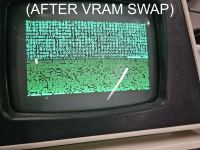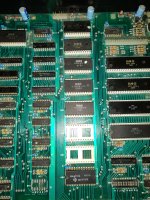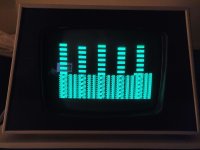BowmakerFox
Member
- Joined
- Mar 7, 2024
- Messages
- 16
Greetings all,
I'm new here, but thought this might be the right place to ask for any kind advice in fixing a PET I acquired recently. I've attached several images of what occurs on boot having cleaned the board and sockets to hell and back.
I suspected initially that the issue was VRAM, so I swapped the original MOS MPS 2114s for two NEC UPD2114LO-2s that I've used with no issues in several C64s. As attached, the weird garbled mess on the screen is different, and swapping the new VRAMs around seems to change which characters are in what position; otherwise (without swapping positions), they are the same on every boot.
There's no familiar beep / chime when switched on, and having removed the 6502 seems to have absolutely no effect on what's displayed.
I've also checked the voltages on each power line and they correspond to the diagrams, give or take ~10%. The traces all seem visually spotless too.
Don't suppose anyone has any advice on what could be at fault, or what to check (and how, I am a little dim).
Thanks again!
I'm new here, but thought this might be the right place to ask for any kind advice in fixing a PET I acquired recently. I've attached several images of what occurs on boot having cleaned the board and sockets to hell and back.
I suspected initially that the issue was VRAM, so I swapped the original MOS MPS 2114s for two NEC UPD2114LO-2s that I've used with no issues in several C64s. As attached, the weird garbled mess on the screen is different, and swapping the new VRAMs around seems to change which characters are in what position; otherwise (without swapping positions), they are the same on every boot.
There's no familiar beep / chime when switched on, and having removed the 6502 seems to have absolutely no effect on what's displayed.
I've also checked the voltages on each power line and they correspond to the diagrams, give or take ~10%. The traces all seem visually spotless too.
Don't suppose anyone has any advice on what could be at fault, or what to check (and how, I am a little dim).
Thanks again!




